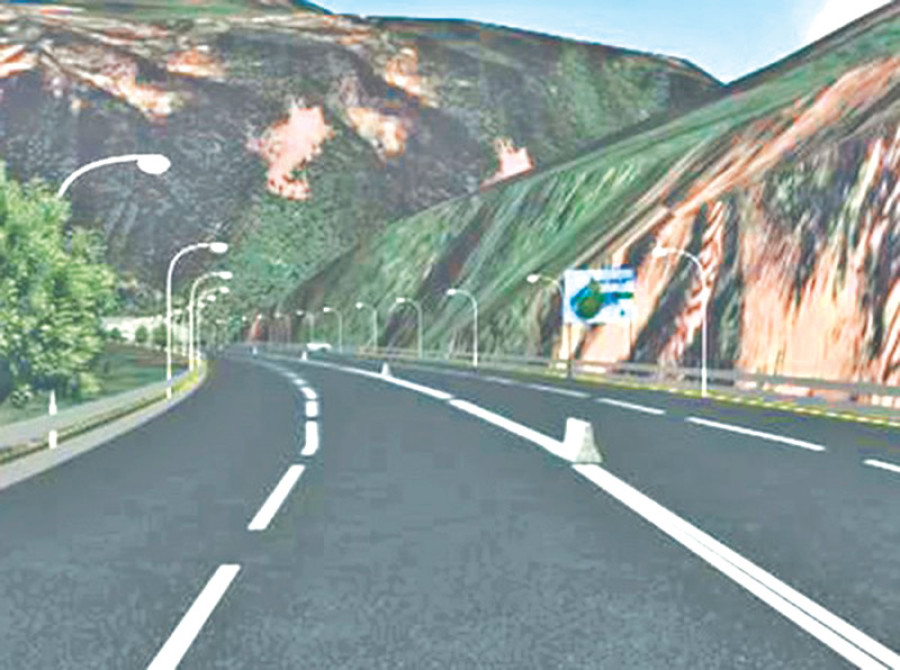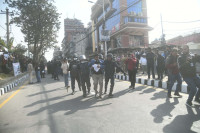Opinion
Long road ahead
The government has decided to build the Kathmandu-Tarai Fast Track on its own as per the detailed project report (DPR) prepared by Infrastructure Leasing & Financial Services Limited (IL&FS). Construction of the expressway must be started immediately as it can contribute to the country’s economic transformation.
Ashish Gajurel
The government has decided to build the Kathmandu-Tarai Fast Track on its own as per the detailed project report (DPR) prepared by Infrastructure Leasing & Financial Services Limited (IL&FS). Construction of the expressway must be started immediately as it can contribute to the country’s economic transformation. The success of the planned international airport in Nijgadh is also critically linked to this project. In our neighbouring countries India and China, such strategically important expressways are built by the government. The public-private partnership (PPP) model for the development of roadways has not had much success in either country. The PPP concept started in India in 1993, and the overall experience has been mixed. In China, only 22 percent of PPP projects started on time.
No roadmap
Against this backdrop, the Nepal government’s decision to build the fast track by itself is a wise one. However, it has not said when the project will start, where the financing will come from and what institution will be responsible for the project’s development. Past experience makes us doubt whether construction will begin immediately. While the project affected people have been demonstrating and demanding that work be started right away, the government lacks a clear roadmap to develop a project of this magnitude.
The study done by Indian company IL&FS has highlighted various risks associated with this project. The major ones are geological and geotechnical risks along with technical risks, including construction of a 1.35-km tunnel with other short tunnels and viaducts. The cost of the project is estimated to be $1 billion. It is normal for projects of this size to go into cost and time overruns. So it is highly probable that the project will not be completed in five years as planned and at the pre-determined cost. Recent landslides on the Mugling-Narayanghat road where widening work is being done is a live example to the potential problems that can arise during construction of highways in hilly terrain. Land acquisition in urban areas is another major problem; it is yet to be completed in Khokana, Lalitpur.
An empowered and independent project office needs to be established for the development and operation of such large projects. For this purpose, a separate law should be formulated empowering the project to take independent decisions on staff recruitment and other important issues. For example, Delhi Metro Rail Corporation was established in India under the Companies Act to develop this project under the Delhi Metro Act.
The government has decided to allocate Rs10 billion annually for the development of the Kathmandu-Tarai Fast Track. The project is expected to take longer than the estimated five years. For instance, the Sindhuli-Dhulikhel highway developed by the Japan International Cooperation Agency (Jica) started in 1996 and was completed in 2015. It took 19 years to construct a 158-km single-lane highway. Learning from such experiences, the government must formulate a clear vision on a practical development modality for strategic roads like the Fast Track. An independent project office staffed by qualified and experienced personnel will prevent the project from stalling due to various problems that can arise during the implementation phase, including forest and environmental issues.
Feasible options
Engineering procurement construction (EPC) contracts can be awarded to national and international contractors through open competitive bidding to build the Fast Track. Countries that lack competitive contractors award construction contracts to international companies. For instance, foreign contractors are used for the development of large infrastructure projects in the United Arab Emirates. An American company Bechtel was contracted to upgrade and expand Dubai International Airport. In the same manner, Nepal can hire experienced international contractors, specifically to construct tunnels and viaducts.
The DPR for the Kathmandu-Tarai Fast Track was prepared with the view of developing it under the PPP model. Therefore, the DPR must be reviewed and updated since the development modality has changed. The proposed international airport in Nijgadh and the Fast Track are strategically related. The airport’s successful operation hinges on the completion of the Fast Track.
Construction of economically important strategic roads should not be delayed at any cost. For this purpose, there is a need for clear vision, strong willpower and decisive action. To manage financial resources, the government can take soft loans from bilateral and multilateral institutions besides dipping into its reserves and raising money from the public. The project can be awarded to the private sector to operate and manage under the PPP model after it is completed. Private players are more efficient in terms of operations, management and maintenance compared to the public sector.
Lately, the government has been mulling over the possibility of handing the Fast Track project to the Nepali Army. While the Nepali Army has experience in building roads, the responsibility for constructing roads lies with the Ministry of Physical Infrastructure and Transport and the Department of Roads. The involvement of the concerned authorities in the construction of such projects will help to improve their skills and capabilities, and this will be helpful for the development of such infrastructure in the future.
Gajurel is a transportation and traffic engineer




 8.12°C Kathmandu
8.12°C Kathmandu










